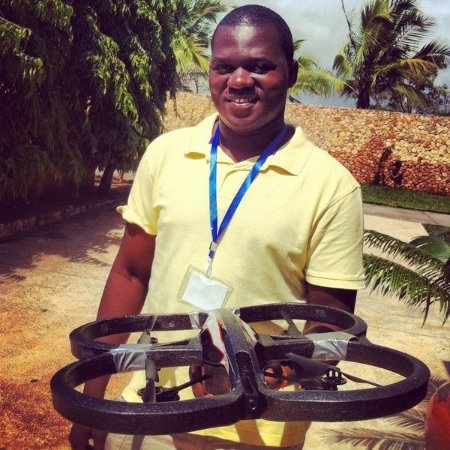
Dickens Olewe, founder of African skyCAM, on drone journalism: "Is there a perception problem? You bet there is."
In January, CNN and the Federal Aviation Administration (FAA) reached an agreement to test the use of drones in reporting. This announcement came in the face of federal regulations banning the use of drones for commercial purposes. In the same month, Kenya banned civilian drone use.
From restrictive laws to societal stigma, drone journalists face many challenges in reporting with this innovative technology. "Governments have their concerns which are legitimate," says Kenyan journalist Dickens Olewe, a former John S. Knight Journalism Fellow at Stanford University and a drone journalism expert. "But we have a professional interest in using drones. There has to be some way we can guarantee professional operation."
Dickens' drone journalism project African skyCAM was a winner of the 2012 African News Innovation Challenge, a competition organized by ICFJ Knight Fellow Justin Arenstein. ICFJ talked to Olewe about how drones can provide unparalleled video coverage of important stories and what steps are being taken to ensure their future as a valuable journalistic tool.
What is drone journalism?
A drone is an Unmanned Aerial Vehicle (or UAV). What you use it for is what determines what kind of work you want to achieve. You could be a farmer using it to monitor your crops, or you could be emergency services using it for rescue missions. In our case, we are using it to gather stories.
What do drones offer journalists?
The applications could be aerial imaging or collecting data. I came up with the idea for my project, African skyCAM, after I looked at how Kenyan journalists were covering floods. I found out that, when it came to imaging, reporters were hitching rides in police helicopters. There was an issue of editorial independence. I thought that this technology could give us the same aerial images at a fraction of the cost of helicopter rides as well as maintain a journalist’s independence.
What kinds of stories are drones particularly apt to cover?
The one that comes to mind is Nepal. The earthquake in Nepal [in April 2015] killed 8,000 to 10,000 people. Journalists, especially Western journalists, parachuted into the country and everyone was flying drones. You could appreciate the scale of the disaster more with these images. That was a really compelling story.
I have yet to see [drones covering] the migrants from Africa coursing through the Mediterranean to Europe. The story is a tough story to cover. You don’t just want to go there with your drone and fly over people who are fighting for their lives. But the headlines said at least 1,000 people were attempting to cross the Mediterranean every day. I would like to see what that looks like.
Is there a stigma that drone journalists have to overcome?
I used to worry about that. I was one of the people who went through the phase of trying to say “don’t say drones, call them UAVs, call them flying cameras” and other softer terms. At the end of the day, we were being too sensitive. When we go out, people still call it a drone. It is what it is. But is there a perception problem? You bet there is.
What challenges do drone journalists face in producing their work?
The regulation in the U.S. is largely that if you are a hobbyist you can operate, but if you want to use a drone for commercial use including journalism, that is banned. The latest rules published by the FAA suggest they are looking at ways to integrate drones into commercial operations.
In [Kenya], the government banned drones in general. We are now seeing how we can influence the conversation. We have to be up front about how we can operate professionally. The government might be freaked out or uninformed, but their concerns about health and safety are valid. A drone can carry a camera, but it can also carry something else.
The distinction between using drones for recreational and commercial use seems vague.
In the United States, if I’m a farmer, and I fly a drone over my crops and put it on YouTube saying: “Check out my corn,” that’s OK. If I use the images to make a commercial, that’s considered commercial use. I’m selling my corn; I’m using a drone for commercial purposes. It’s as ridiculous as that.
Journalists are prevented from flying drones because they do newsgathering and production. The loophole was that journalists could ask a member of the public to fly the drone, get the footage and give it to whomever. The FAA has now said if that person happens to capture it, they can share the footage, but [news outlets] can’t solicit that footage because it would be illegal.
What can journalists do to ease these concerns?
Journalists have an overriding responsibility to show a professional, sensible way of operating. For example, I covered a political rally, so I sought out the police and showed them the equipment. They said, “OK, that’s great.” We pulled the drone out of the case. We walked around with it so people could actually see it, and we operated. That shows a level of transparency.
Who is leading the charge for drone journalism?
The Professional Society of Drone Journalists is doing fantastic work. The group is reaching out to different governments, submitting papers, and helping members in different countries with resources.
While I was at Stanford, I organized a conference which brought together lawyers, journalists, drone manufacturers and techies. I want to take that conversation to Africa. I’m talking to different funders to see how that can work. I hope before the end of the year I’ll be able to organize a similar conference.
Main image and homepage slideshow images courtesy of Dickens Olewe.